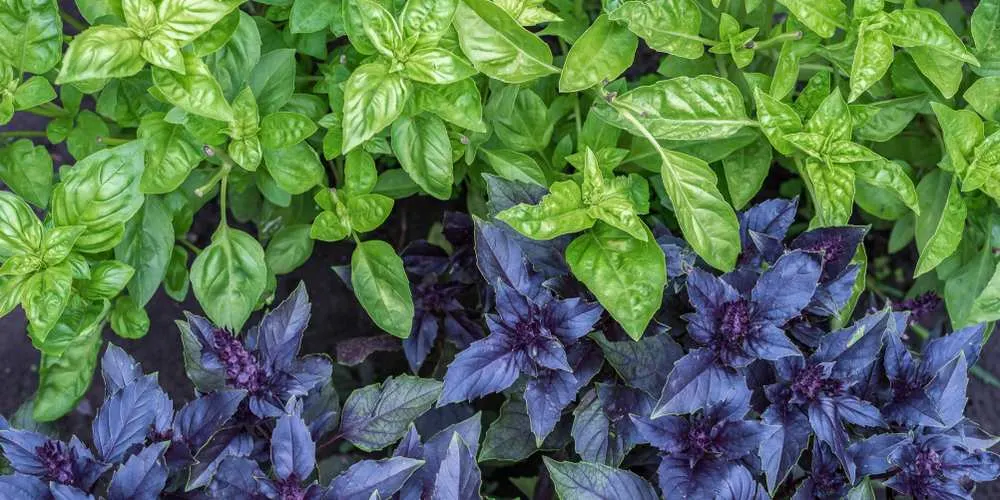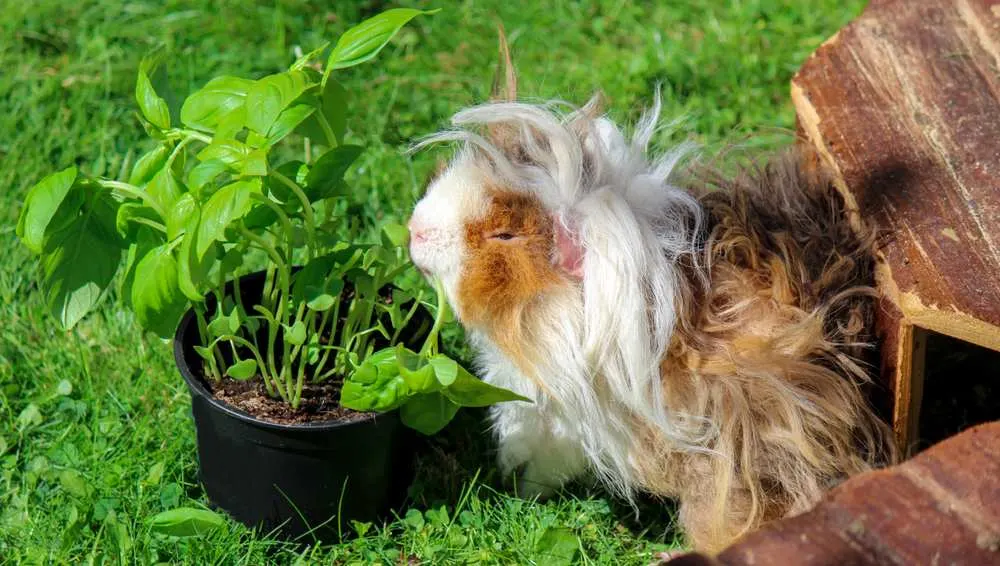It is very easy to assume that herbivores are allowed to eat absolutely all plants. Well, it’s not always like that. What is the situation between basil and guinea pigs?
You’ve probably heard a lot about basil. This is a plant that came from Asia and is widely cultivated, and it can be used for culinary purposes. However, not all animals are allowed to consume this leafy green. What about guinea pigs?
Can guinea pigs eat basil? Yes, they can, and I’m going to show you how to serve it correctly.
So, if you’re all about the right dietary plan and you want to educate yourself on the topic of basil, keep scrolling down!

A Hint Of Basil
Let’s begin.
I will open this discussion by saying that your guinea pig is allowed to eat basil and that this is not everyday food.
The question follows: If guinea pigs are herbivores, then why can’t basil be included in everyday meals? Basil is a plant with a strong composition, and serving it in excessive amounts can harm your pet.
Does every guinea pig love basil?
Each guinea pig is unique, and of course, it can happen that it simply did not like this plant. That is why it is very important to observe it while eating this type of food for the first time.
Guinea pigs are allowed to eat the following parts of the basil plant:
- Raw fresh basil leaves
- Stems
- Flowers
If at any time you notice that your guinea pig is protesting against this food or showing any signs of discomfort – immediately remove the basil from the food bowl.
The current focus is on those guinea pigs who love basil and are happy to consume it. But basil is not enough just to love. Owners need to learn how to serve it and in what quantities.
Don’t worry. The rules are easy. Here is how you should handle and serve basil to your guinea pig who is consuming this plant for the first time.
- Introduce The Plant To Your Pet.
Start by placing a small portion of the basil leaf next to the food of your guinea pig. After eating his daily food, he will probably want to get a taste of this new ingredient. If it proceeds with eating it, basil is considered approved.
- Check On Your Pet After Trying Basil.
After your guinea pig has accepted basil and eaten a certain amount, it would be good to check the condition after eating. Pay attention to diarrhea signs, bloating, stomach aches, etc.
- Continue Feeding Your Guinea Pig Basil Occasionally.
After the eating went well and everything turned out to be okay with your pet after consuming basil, continue to include this plant in her diet, BUT OCCASIONALLY.
How Often And How Much Can Guinea Pigs Eat Basil?
Since this is a slightly stronger plant, it is essential to pay attention to the weekly measure and not overdo it.
Guinea pigs are allowed to eat 1-2 basil leaves per serving. Of course, pay attention to size of the leaf. As for the weekly dose, 2 to 3 times a week consuming basil is quite enough. Anything beyond this measure can be harmful.
Attention:
- When serving basil, it is very important to cut the leaves into small pieces. Never give large leaves to your guinea pig because this kind of serving will most often cause choking.
- With guinea pigs whose teeth have not fully developed, observe it while eating.
- Baby guinea pigs are not allowed to consume basil.
Basil is not the only leafy green your guinea pig is allowed to consume.
Read also: Can Guinea Pigs Eat Arugula?

Basil – Nutritional Facts
Here’s what one tablespoon of fresh basil contains.
| Nutrient | Amount | RDI |
|---|---|---|
| Calories | 0.6 | / |
| Vitamin A | 139 IU | 3.00% |
| Vitamin C | 0.5 mg | 1.00% |
| Vitamin K | 11 mcg | 14.00% |
| Calcium | 5 mg | 0.50% |
| Iron | 0.1 mg | 0.50% |
| Magnesium | 0.5 mg | 1.50% |
There is more than one type of basil.
| Sweet basil | This is the most popular type of basil. It is famously used in many Italian dishes and most supermarkets sell it dried, but you can also find fresh sweet basil leaves. |
| Greek basil | Greek basil has the strongest taste, and that’s why you should avoid feeding it to your guinea pig. This type is most commonly grown in pots. |
| Thai basil | This is the oldest basil type, and it’s used in many traditional dishes all around Asia. |
| Cinnamon basil | Cinnamon basil originates from Mexico. This type of basil is a little spicy and should be avoided around guinea pigs. |
| Lettuce basil | This is the safest type of basil to feed your guinea pig. It has soft, big, and wrinkled leaves, and it’s delicious when freshly chopped. |
Now, let’s mention the shelf life of basil.
Unfortunately, basil doesn’t have a long shelf life. After you buy it, it can stay fresh for 5-7 days if stored properly. After that, it will slowly start to go bad. You can either grow basil or buy it in your local food market or in a grocery store.
How can you tell that your basil is bad?
First, take a look at the color. Fresh basil should be green. If your basil is turning black or has some slightly brown spots on it, it’s time to throw it away.
The smell is also an important indicator. You will be able to tell if your basil smells rotten.
You will also notice some moisture. It’s definitely time to discard the plant.

Ways Of Storing
What’s interesting about basil is that it can be stored in more than 2 ways, and here are some of the choices you can choose from:
- Storing a bouquet of basil leaves
- Stashing the leaves in the fridge
- Freezing fresh basil leaves
- Keeping the basil in a pot
Storing A Bouquet Of Basil Leaves
- Take a small vase or a jar and fill it with water. Use bottled water for better results
- Chop the bottom of the basil – 2cm of its stems.
- Put the basil in the jar.
- Change the water every 2 days and check on your plant.
Stashing The Leaves In The Fridge
- Pick basil leaves and wash them under cool water.
- Let the leaves dry on paper towels.
- Wrap the leaves in dry paper towels. (use new ones)
- Put the leaves in a zip-bag and close it.
- Leave the leaves in the fridge for 24h.
Freezing Fresh Basil Leaves
- Prepare boiling water and an iced pot.
- Wash the basil leaves and put them in boiling water for 2 mins.
- Take them out and transfer them into the iced pot for 1 min.
- Dry the leaves on paper towels.
- Put the leaves in the freezer bag and store them in your freezer, of course.
Keeping Basil In A Pot
- Buy a regular plant pot in your local garden store.
- Place the pot on a window where there’s a lot of sunlight.
- Don’t fill the pot with too much basil.
- Pluck the fresh leaves when you need them (for your guinea pig).
- Water the pot a couple of times a week.

Health Benefits & Hazards
Basil leaves have their good and bad sides. It’s time to reveal what they are. Let’s start with the good sides of consuming basil.
- Preventing diarrhea: If your guinea pig consumes basil leaves occasionally and it is the right amount, it can prevent diarrhea. It’s also great for calming stomach aches. But it would be best if you didn’t overdo it.
- Reducing inflammation: Consuming basil can help your guinea pig fight internal inflammation.
- Keeping the skin healthy: Your guinea pig’s skin and coat maintenance is essential, and giving them basil leaves from time to time will make their coat shiny, thick, and healthy.
- Treating fungal infections: If your guinea pig has suffered a fungal infection recently, you should definitely include some freshly chopped basil leaves.
- Improving digestion: Basil is a plant that’s easily digested, and your guinea pig’s organism will have no problem processing it.
- Maintaining strong bones and teeth: Bone and teeth development is essential for every pet. So, as your guinea pig grows up, try including some basil leaves for bone density and teeth health.
- Improving vision: Older guinea pigs might start having trouble with their vision, and including some basil leaves in their diet can help lower the chances of specific eye problems.
The benefits are looking pretty good, but what about some downsides of too much basil?
Some of the problems that can arise from too much of this leafy green are:
- Stomach aches
- Diarrhea
- Weakness
- Loss of appetite
- Constipation
You will be able to notice when your guinea pig has had enough of this, and it will show it by avoiding any other food that you bring, not just basil.
While some of the following health problems can be treated by hydration and removing basil from their diet for a certain period, others require consultation with a professional.
So, if you notice that days have gone by and your guinea pig is still not getting better, you should take it to the vet immediately.

Other Healthy Choices
Don’t worry. If your guinea pig didn’t have a great experience with basil, there are still a lot of other healthy treats you can turn to. Some of them include:
If you’re interested in exploring the dietary requirements of guinea pigs further, go check this out: What Can Guinea Pigs Eat? The Complete Guide For Guinea Pigs

